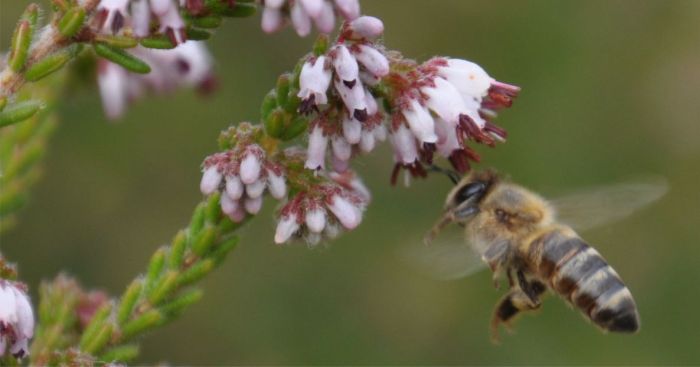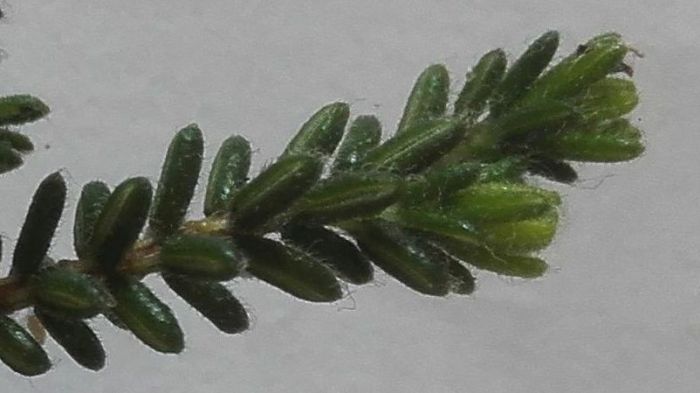Erica ericoides
Erica ericoides (L.) E.G.H.Oliv.
Family: Ericaceae
Common names: honey heath, erica heath (Eng.); heuningheide (Afr.)
Introduction
This evergreen shrub produces masses of small pink flowers, with a distinctive, honey-like scent, in late summer, from January to May, and attracts lots of honey bees to the garden. It is quite happy with reduced water application once established.

Description
Description
This shrub is dense, compact, quite well-branched and grows up to ± 500 mm high. The branches are usually covered with hairs. The rough, hairy leaves appear in whorls of 4. The pale pink to rose pink flowers are displayed in dense, terminal clusters and have hairy stalks, with 3 sticky bracts that are pressed quite tightly to the calyx. The tubular bell shaped flowers are hairless, 2.5–4 mm long, with 4 spreading lobes and show 4 exserted anthers.

Erica ericoides is quite similar in appearance to Erica barbigeroides and Erica russakiana, to the untrained eye. Closer observation reveals that Erica barbigeroides differs from Erica ericoides and Erica russakiana in terms of the number of flowers in the flower head, it has up to 24 flowers compared to up to 16 flowers in the two closely related species. The size of the flowers can be up to 6 mm long and is the longest, compared to Erica ericoides and Erica russakiana. The bracts of Erica barbigeroides are double the size of the sepals and broader towards the tip. The calyx and bracts in Erica ericoides and Erica russakiana are more or less the same length and similar to each other. Erica barbigeroides flowers earlier than the two other species, usually in early summer, from October to January, and has established itself in the Kogelberg and Napier areas.

The anthers of Erica russakiana have distinct tails, unlike Erica barbigeroides and Erica ericoides, however Erica ericoides sometimes shows shorter ones. Erica russakiana grows up to 300 mm high, much lower than Erica ericoides,the calyx is more than half the length of the flower size. E. russakiana produces flowers in midsummer, from December to January, and it is very rare, only found in the Klein River Mountains and Caledon Swartberg area.
Erica ericoides can also be confused with Erica labialis, Erica glabella, Erica similis, Erica benthamiana, Erica equisetifolia and Erica nudiflora, all of which share the same habit and have similar looking flowers. One has to pay close attention to the leaves, calyx, bracts and bracteoles, petiole, anthers, corolla lobes and hairiness, to tell them apart.
Conservation Status
Status
Erica ericoides is not threatened, it has a conservation status of Least Concern (LC).

Distribution and habitat
Distribution description
This plant is endemic to South Africa, it has established itself in the Western Cape on the lower mountain slopes and flats, from the Cape Peninsula to Napier.
Derivation of name and historical aspects
History
The genus name Erica is derived from the Greek word ereiko, which means ‘to break’ or ‘rend’; this could refer to the stems of the plant that are not very tough and break or tear easily. In turn ereiko is the Latin word for heath or broom. The specific epithet ericoides is Latin and means ‘looking like an erica’ which especially refers to the tough sclerophyllous leaves like those of heather. This plant was first placed by Linnaeus into the genus Blaeria, because it has 4 stamens and a single ovary, and at the time he accepted the genus Erica to have 8 stamens. The genus was named after Patrick Blair, who was a Scottish botanist. However, Blaeria was later realised to be closely related enough to be re-classified as part of the Erica genus. Erica russakiana and Erica barbigeroides also formerly belonged in the genus Blaeria.

The genus Erica comprises of about 860 species of which about 690 are endemic to the southwestern tip of South Africa. Ericas are one of the most important groups of plants of fynbos vegetation. Heaths occur in East Africa, the Mediterranean as well as Europe but in significantly lower numbers, a collective total of about 28 species were recorded.
Ecology
Ecology
This species regenerates readily from seed, which is produced in abundance. In general, the seeds of heaths are very small and stay viable for many years in the soil seedbank.
Erica ericoides is known to be pollinated by bees. The bees obtain pollen from the flowers, as food, this action at the same time carries pollen from the one flower to the other and plays a main role in carrying out the pollination process.

Uses
Use
Erica ericodes is an attractive species, it flowers over a long period. This plant can be very successfully grown alongside members of the Restionaceae family and other groups of fynbos plants, such as members of the Rutaceae and Proteaceae, which also make ideal companions in the garden. It also grows well in pots, regular pruning will benefit plant health and flowering. It is also suitable to be grown as a low hedge.

Growing Erica ericoides
Grow
Erica ericoides will grow happily in a soil with good drainage and a pH around 5.5 to 6.7. Avoid areas in the garden where the plant will be shaded for most of the day, or where it will experience extreme heat in summer. When planting among other fynbos plants, avoid overcrowding the plants, because poor air circulation may create a micro climate that enables fungal growth. Weed lightly around plants to prevent damaging their delicate hair-like root system. Regular pruning after flowering and feeding is important to encourage new growth.
Take 40-50 mm cuttings from semi-hard wood, 2 months after flowering. Heel cuttings are ideal, however nodal cuttings can also deliver good results. Remove the lower third of the cutting’s leaves. Apply a rooting hormone for semi-hardwood to the cutting, this will speed up the root development. Place the cuttings in a rooting medium made up of 50% fine-milled bark and 50% polystyrene chips. Heel cuttings from thin, actively growing side shoots respond more positively when it comes to root development. The cuttings develop best when good air circulation is maintained. Good air circulation is important as it reduces fungal infections. A specialised facility, such as a propagation unit with heated benches and a misting system, is best to successfully propagate this plant by cuttings. Cuttings can be planted into small pots when rooted, in a soil mixture of 8 parts bark and 3 parts sand. Feed every 2 weeks with an organic liquid fertiliser.
Sow seeds in seed trays about a 100 mm deep, filled with equal parts of river sand and sifted, composted bark, in autumn. Wet the medium with fynbos smoke extract (obtained from burning fynbos plant material) and only use pure water after one day. The seeds are very small and need to be mixed with fine river sand prior to sowing, in order to obtain a more even spread of the seeds. Keep the medium moist by watering with a fine hose. Place the trays in a warm and sheltered spot to encourage the germination process. The seeds show signs of germination after 6–10 weeks. Seedlings can be planted out into small pots as soon as they are about 10 mm high. Thereafter, plant the plants in garden beds as soon as they are ± 100 mm tall.
References
- Baker, H.A. & Oliver, E.G.H. 1967. Ericas in southern Africa. Purnell & Sons, Cape Town.
- Bond, P. & Goldblatt, P. 1984. Plants of the Cape flora. A descriptive catalogue. Journal of South African Botany Suppl. Vol. 13. National Botanic Gardens of South Africa, Kirstenbosch, Cape Town.
- Foden, W. & Potter, L. 2005. Erica ericoides (L.) E.G.H.Oliv. National Assessment: Red List of South African Plants version 2020.1. Accessed on 2021/05/21
- Goldblatt, P. & Manning, J. 2000. Cape Plants. A conspectus of the Cape flora of South Africa. Strelitzia 9. National Botanical Institute, Pretoria & Missouri Botanical Garden, Missouri.
- Oliver, I. & Oliver, T. 2000. Field guide to the ericas of the Cape Peninsula. Protea Atlas Project, Cape Town.
- Phillipskop Mountain Reserve. Honey Heath. https://www.phillipskop.co.za/flora/erica-ericoides. Accessed on 13/06/2021.
- Schumann, D., Kirsten, G. & Oliver, E.G.H. 1992. Ericas of South Africa. Fernwood Press, Vlaeberg.
- Smith, C.A. 1966. Common names of South African plants. Memoirs of the Botanical Survey of South Africa No. 35. Government Printer, Pretoria.
- World Flora Online. 2021. Erica barbigeroides E.G.H.Oliv. Published on the Internet. http://www.worldfloraonline.org/taxon/wfo-0000671479. Accessed on 13/06/2021.
Credits
Benjamin Festus
Kirstenbosch National Botanical Garden
July 2021
Acknowledgements: the author thanks Alice Notten for providing some of the images.
Plant Attributes:
Plant Type: Shrub
SA Distribution: Western Cape
Soil type: Sandy, Loam
Flowering season: Late Summer, Autumn
PH: Acid
Flower colour: Pink
Aspect: Full Sun
Gardening skill: Average
Special Features:
Horticultural zones








Rate this article
Article well written and informative
Rate this plant
Is this an interesting plant?
Login to add your Comment
Back to topNot registered yet? Click here to register.